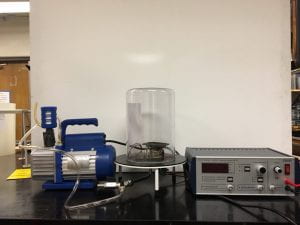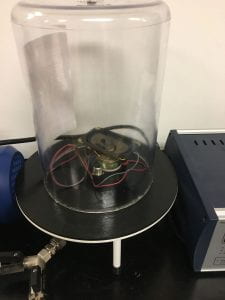Equipment:
- Fredrikson Function Generator
- Vacuum Pump
- Glass Dome
- Small Speaker
Demo:
- Hook up the vacuum pump and connect the clear hose between the base of the glass dome and the vacuum pumps suction input.
- Pull off the glass dome, plug the speaker into the banana jack inputs in the base and replace the glass dome fully enclosing the speaker and wiring.
- Connect the outputs of the speaker to the function generator and switch it on. You should hear the speaker ring.
- As the speaker is ringing, evacuate the chamber by opening the valve (so that it is parallel with the hose) and turning the pump on. You should hear the ringing volume decrease until it is effectively silent.
- If you close the valve and turn the pump off, then open the valve again, you should hear the ringing from the speaker return.
Explanation:
Sound is a form of longitudinal wave propagation that can only travel through a medium. Longitudinal waves are formed by a series of compressions and rarefactions. This is easily demonstrated by the slinky demo or the longitudinal wave demo.
Longitudinal wave propagation is when the direction of propagation (k) is parallel to the direction of polarization (n).
All physical wavelengths are governed by the infamous wave equation:
Where v is dependent upon the medium.
Sounds travels in gases through alternating compressions and rarefactions of air density and pressure. More dense air has more particles and higher pressure, less dense air has less particles and lower pressure. Sound travels even better in liquids, since the density of the medium is already higher. Solids are even better transmitters of sound since they have a higher elastic modulus than both liquids and gases. From the wave equation, we can derive:
where is the density of the gas, P is the pressure of the gas, Y is the Young’s modulus and
is the bulk modulus.
is the ratio of the specific heat of gas at constant pressure over the specific heat of gas at constant volume.
Clearly, each formula exhibits a relationship. Thus, as
,
. In other words, as the glass dome is evacuated, the velocity of the sound wave from the speaker tends to c. This mathematically explains why when the density of the gas (amount of particles) is 0 – what we call a vacuum – the sound waves do not travel.
Notes:
- A fun idea is to have a student put a song on their phone and place the phone inside of the chamber.
Written by Phoenix Gallagher

